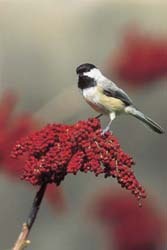What to know about Chickadees
General Information
• There are seven species of chickadee found in North America. This includes the Black-capped, Carolina, Mountain, Boreal, Mexican, Chestnut-backed, and Gray-headed Chickadee. Of these seven, only two are found in North Carolina, the Black-capped Chickadee can be found in the Appalachian region while the Carolina Chickadee is found throughout the state.
o Despite its name, the Carolina Chickadee is found through a wide range of southern states outside of the Carolinas.
o Chickadees are easily identified by their namesake call “chick-a-dee.” This call is different from their song which is a four note whistle of “fee-bee fee-bay”
• Chestnut-backed and Black-capped Chickadees watch other birds’ foraging habits to see if they should adapt their behavior to be more successful.
• Carolina Chickadees can be found in wide variety of areas, but prefer habitats that have deciduous or mixed-deciduous with coniferous woodlands. They can be found in open woods and parks, and both urban and suburban areas.
• During migration and winter, Carolina Chickadees will often flock with each other. Not only that, but many other species such as Tufted titmice, Black-capped chickadees, woodpeckers, kinglets, and Brown Creepers often join the flocks. These mixed flocks provide better protection for all individuals involved, and it is common for titmice and chickadees to be the leaders of these flocks as they are known very well for their system of alarm calls when predators are nearby.
• Chickadees weigh less than half an ounce.
• Chickadees do not migrate and are equipped to survive harsh winter weather. They cache foods and remember where they are hidden, have dense winter coats, diligently find excellent, well-insulated roosting cavities and can perform a regulated hypothermia to conserve energy overnight.
Feeding Behavior
• Carolina Chickadees are omnivorous and have a diet of both plants and insects.
o In wintertime, their diet is split 50-50 between plants and insects. The rest of the year, their primary diet consists of small insects.
• Though chickadees are regular visitors to feeders, over 75% of their winter food supply still comes from natural sources.
o When the temperature falls below 10º F, research has shown that the survival rate of chickadees almost doubled when they had access to feeders.
• Their size and beak shape makes it easy for them to flutter in place while trying to grab insects on the undersides of leaves and the trunks of trees. Whether it is seed or insect, they will hold their food between their toes and the tree limb their perched on and peck into it.
• Chickadees can gain as much as 10% of their body weight each day and lose it all again during a cold winter night.
Nesting Behavior
• Chickadees are generally monogamous and stay with the same mate for life.
• They are cavity nesters and will excavate their own nest site in rotten or decaying wood. They will also use an old woodpecker hole or an available nesting box.
o Some of the common nesting materials Carolina Chickadees use include moss and strips of bark.
• They are one of the earlier songbird species to start nesting in March along with Carolina Wrens and Eastern Bluebirds. They lay one brood per nesting season, but they can lay anywhere from 3-10 eggs in a brood!
o Their eggs are primarily white with fine spots or reddish-brown blotches.


